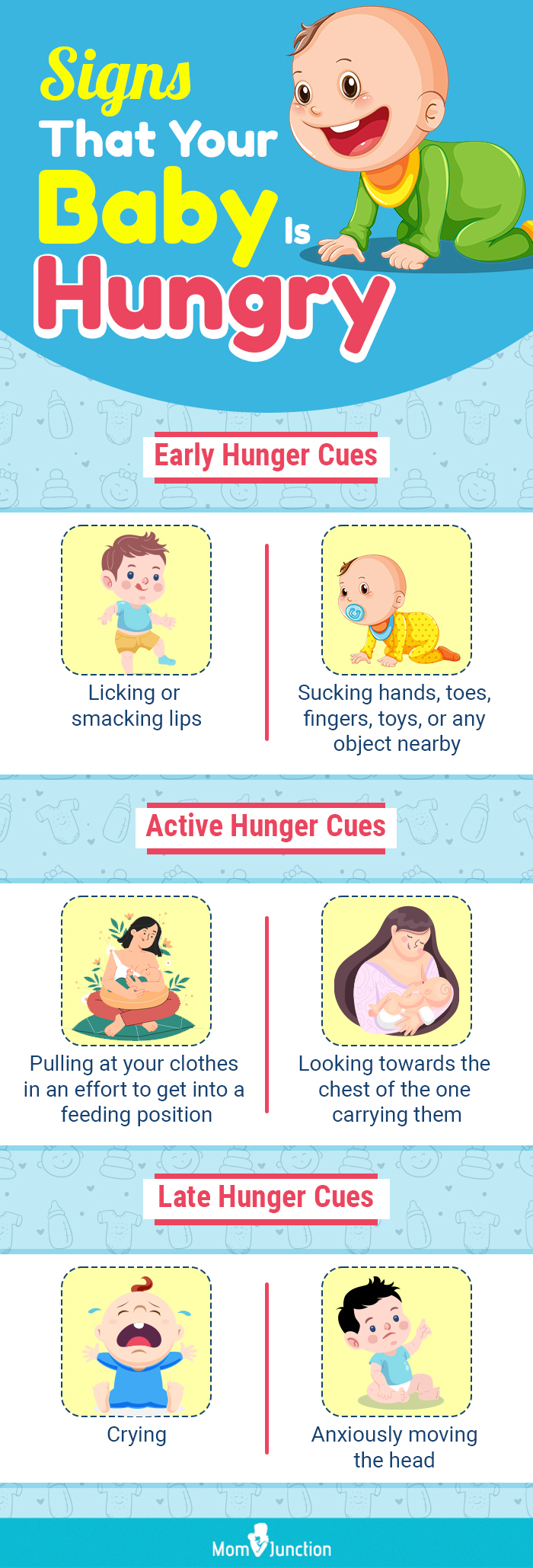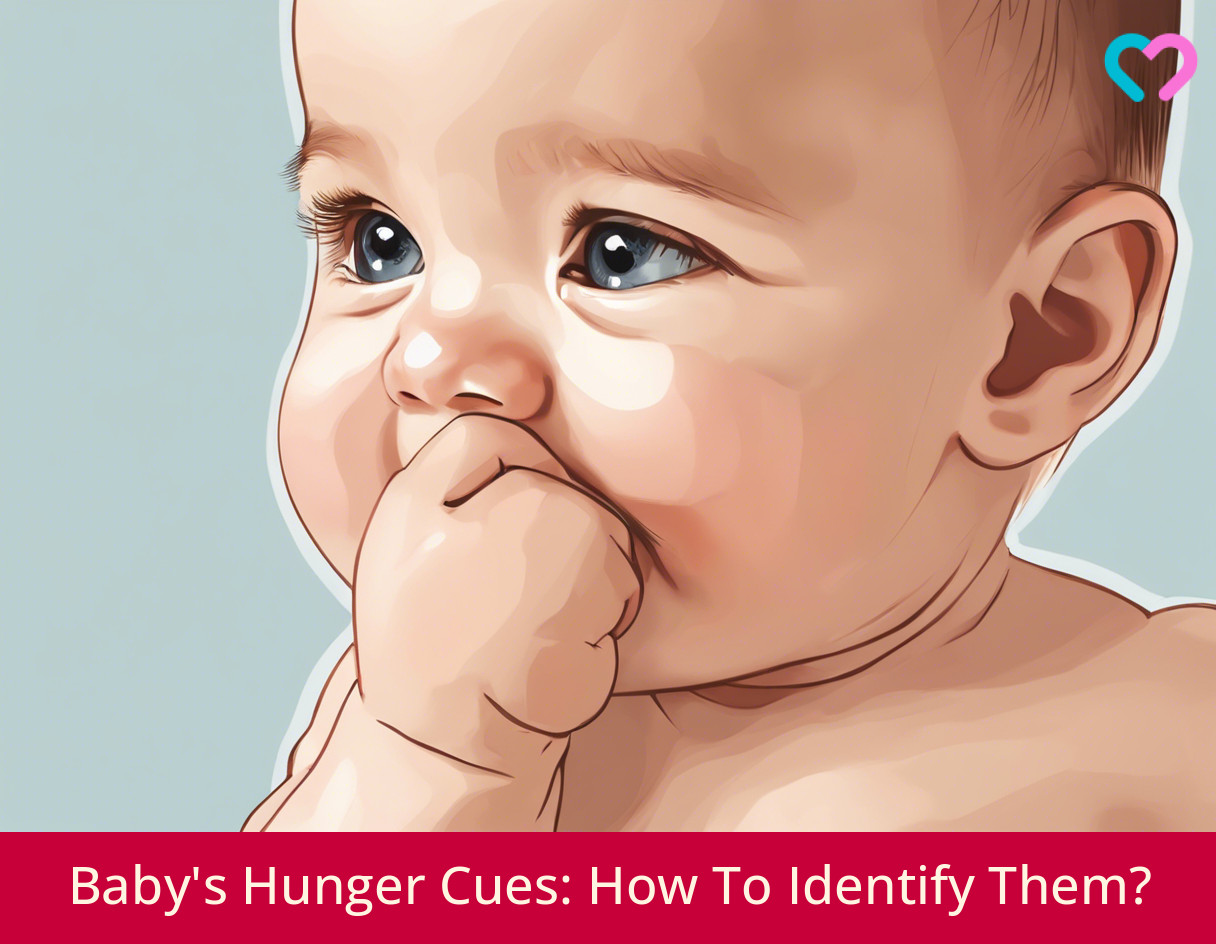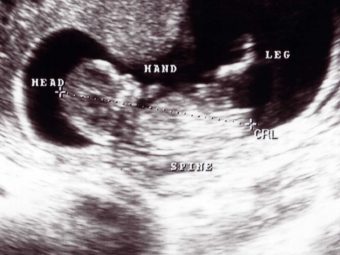
Image: Shutterstock
Most new moms may ask themselves, “Is my baby hungry?” and “What is a good time to feed my baby?” Finding the answer to all of these questions is easy. With a bit of research, you will be able to identify the baby hunger cues your little one gives out to let you know they are hungry.
So, rather than worrying about when to feed your baby or how much to feed your baby, it’s a good idea to feed your baby only when they are hungry. Keep an understanding on your baby’s behavior by considering the hunger cues we’ve mentioned in this article.
Different Baby Hunger Cues
Most parents think that crying is a hunger signal. But it is a late hunger cue. The baby shows many more cues early on. By utilizing your maternal instinct to identify these early cues, feeding your child will become a smoother process.
Below is a list of baby hunger cues that should look for (1) (2) (3).
Early Hunger Cues
Image: IStock
- Licking lips or smacking is the first sign of hunger.
- Sucking on hands, lips, toes, clothes, toys, and fingers.
- Opening and closing the mouth.
- Sticking the tongue out.
- Moving the head from side to side as if looking for something. This movement is called the rooting reflex. During the first weeks of birth, when you stroke the baby’s cheek, the baby turns toward the breast or bottle, as a natural reflex. They make sucking motions with their mouths. Rooting turns into a voluntary action after the babies turn four months old.
Active Hunger Cues
Image: Shutterstock
- Trying to get into a feeding position by pulling on your clothes.
- Turning the head towards the chest of the one carrying the baby.
- Increased agitation involving leg and arm movement.
- Breathing fast or fussing.
- Exhibiting restlessness through squirming or fidgeting.
- Experiencing sleep disturbance characterized by repeatedly waking up and falling asleep in quick succession.
- Displaying irritability through whining sounds, grunts, and discomfort.
- Hitting on your chest or arm constantly.
- A hungry baby may continue showing interest in sucking even after finishing the first breast. It indicates that the little one wants more.
- Babies older than four months may even smile while breastfeeding, indicating their interest in continuing.
Late Hunger Cues
Image: Shutterstock
- Moving the head frantically from one side to the other.
- Crying is the last sign.
- Calm down the crying baby before feeding. Offer skin-to-skin contact first, and then start feeding when they are relatively calm.
Here are the hunger cues to note (3):
| Approximate Age | Hunger cues |
|---|---|
| 0-5 months |
|
| 6 to 23 months |
|
Source: CDC
Benefits Of Following Hunger Cues
Instead of feeding your child randomly based on time gaps, it is always good to look for the cues they give, whether you are formula feeding or breastfeeding. It will benefit you in more than one of these ways (4):
- Helps you get to know your baby well.
- Ensures smooth breastfeeding.
- Satisfies the little one’s nutrition and hydration needs.
- Encourages your baby to trust you.
- Gives you confidence.
- Builds a positive feeding relationship between you and the baby.
- Keeps up the milk supply.
How Often Should A Newborn Feed On Breast Milk?
In the initial days, newborns do not require much milk to feel full as they have tiny stomachs. They may express the need to feed as frequently as every one to three hours. On average, babies must be fed approximately eight to 12 times within a 24-hour period. In addition, regular feeding can help maintain your milk supply and provide your baby with sucking and swallowing practice.
As the baby grows, most exclusively breastfed infants feed every two to four hours. However, there could be instances when babies may exhibit hunger cues as often as every hour. This pattern is known as cluster feeding and is considered normal baby behavior (more common in breastfed infants than formula-fed ones). Cluster feeding typically occurs when there is an increased demand for calories and is often associated with a growth spurt (5) (6).
How To Know When Your Baby Is Full?
Image: IStock
Once your baby is full and satisfied, they show signs that it is done. Satiety cues include (3):
- Closing lips
- Turning the head away from the food source
- Stopping or slowing down sucking (if the baby is breastfeeding)
- Falling asleep, looking calm and relaxed
- Spits out the nipple or solid foods
A baby older than four months may start looking around and seem distracted.
Frequently Asked Questions
1. Is hand sucking always a baby hunger cue?
Hand sucking need not always be a hunger cue once the baby crosses the newborn period. From around six to eight weeks, an infant begins to explore things through his hands and mouth. They gradually get more control over their hands. Sucking on hands is also common in babies before or during teething.>
2. What if I am not sure if it is a hunger cue?
If you suspect one, yet not sure about your baby’s hunger, offer them a feed. It can help both you and your baby in more than one way:
- The little one can have a feed if they are hungry.
- If you are breastfeeding, your milk supply will increase.
- It can reassure and comfort your baby.
If your baby has regularly been nursing yet seems fussy, check for other problems such as discomfort from gas, colic, or tummy ache. If your baby is crying relentlessly and refusing to suck, consult your doctor urgently.
3. Why does my baby show hunger cues shortly after feeding?
It is normal for babies to have feeds between short time gaps. It is called cluster feeding and is more common during the afternoon or late evening.
Babies also tend to feed more during growth spurts, which last two to three days. A growth spurt usually happens at around two to three weeks, six weeks, three months, and six months.
Jess Connell, a mother of two, shares how a growth spurt changed her baby’s feeding patterns. She says, “Well, I think we are moving into growth spurt mode. Instead of every 3-4 hours as he (my baby) had been doing, he woke and ate every 2-2 & 1/2 hours. Then, he wanted to eat at roughly the 2 hour/2 hour, 15-minute mark… Sometimes, like this, I know true hunger is present. So, of course, I feed the baby (i).”
4. Should I wake my sleeping baby for nursing?
Babies are very sleepy during the early days of birth. If the little one is less than four weeks old, wake them once every four hours during nights and once every two to three hours during the day to nurse. Practice this if they are experiencing good weight gain, showing normal parameters, pooping, and peeing.
5. Should I feed my baby with no hunger cues?
A lack of hunger cues doesn’t necessarily mean your baby isn’t hungry. A newborn needs to breastfeed at least 8-12 times a day (2). Feeding babies when they are calm or during the early stage of hunger cues is advisable for a pleasant feeding session.
6. Do clenched fists always mean that my baby is hungry?
Clenched fists are one of the active ways for your baby to tell they are hungry. But clenched fists do not always indicate hunger, as it is a developmental reflex that may be present until six months. So check for more hunger cues and clenched fists to ensure your baby is hungry.
7. Do babies fake hunger cues?
Babies utilize their hunger cues, a type of communication, to signal that they require food. However, sometimes being overtired can make babies act hungry even when they have eaten.
Babies may try to signal their hunger in multiple ways. Since each baby is unique, their appetite may be communicated differently. Hence, you may miss some baby hunger cues at times. However, don’t fret about it since with time and practice in parenting, you will be able to comprehend and recognize your baby’s cues better. Usually, constant crying is a late hunger cue. You may try soothing techniques such as skin-to-skin contact to aid in learning your baby’s feeding cues quickly. Slowly figuring out your little one’s hunger cues will help keep them full and well-nourished.
Infographic: How To Identify Hunger Cues In Babies
Knowing the hunger cues in babies is important for ensuring their healthy growth and development. By recognizing and responding to these cues, parents can also help their baby develop healthy eating habits and a positive relationship with food. So, scroll through the infographic below to learn the different types of hunger cues of a baby. Illustration: Momjunction Design Team
Key Pointers
- Babies show early hunger cues such as licking lips or smacking, sucking, opening and closing the mouth, and sticking the tongue out when hungry.
- Increased leg and arm movement, fussiness, squirming or fidgeting, displaying discomfort, making whining sounds, and grunts are active hunger cues.
- Late hunger cues include frantically moving the head from one side to the other and crying.
- Turning the head away from the food source, stopping or slowing down sucking, falling asleep, and spitting out the nipple or food indicates that the baby is full.

Image: Stable Diffusion/MomJunction Design Team
Learn effective strategies to recognize your baby’s hunger and fullness cues, enabling you to create a healthy feeding schedule. Enhance your ability in understanding their signals and make well-informed choices.
Personal Experience: Source
MomJunction articles include first-hand experiences to provide you with better insights through real-life narratives. Here are the sources of personal accounts referenced in this article.
i. Chronicling babywise- week 3;https://makinghome.blogspot.com/2010/08/chronicling-babywise-week-3.html
References
1. Is your baby hungry or full? Responsive Feeding Explained; Healthy Children; American Academy of Pediatrics
2. Feeding Your Baby: The First Year; Cleveland Clinic
3. Signs Your Child is Hungry or Full; Centers For Disease Control And Prevention
4. Hunger cues; Government of Canada
5. How Much and How Often to Breastfeed; Centers For Disease Control And Prevention
6. Cluster feeding; Arizona Department of Health Services






















